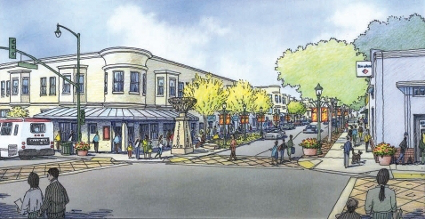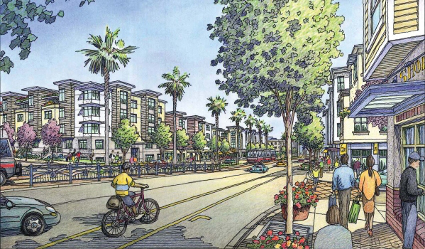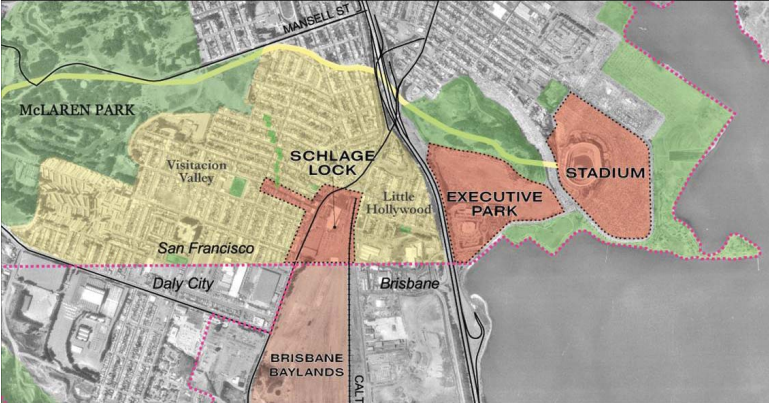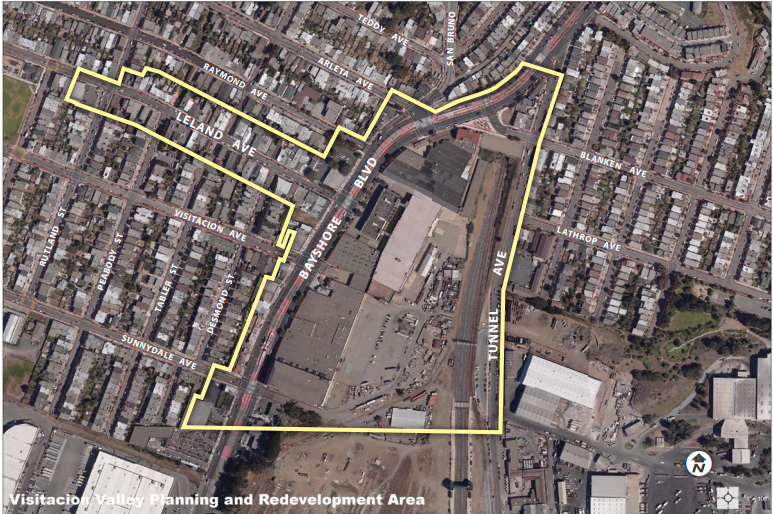
Schlage Lock, Leland Avenue and Bayshore Boulevard, 94134 – Residential (Approved) – 5/16
New Homes in San Francisco – Residential (Approved) – 5/16
Schlage Lock, Leland Avenue and Bayshore Boulevard
Timeline
The Schlage Lock Company left a decades-old legacy on the site that in 2000 spurred on the redevelopment planning effort for the surrounding Visitacion Valley community.
Local Map
March 2000: Home Depot disclosed intentions to open its first San Francisco store at the Schlage Lock property, but drew opposition from Visitacion Valley residents and merchants concerned about traffic congestion and a missed opportunity for integrated redevelopment with the surrounding neighborhood.
August 2000: Responding to community concerns, Supervisor Tom Ammiano carried legislation to change Schlage property zoning from industrial uses to low-scale commercial, in an attempt to block the development of a “big box” Home Depot outlet.
January 2001: Home Depot dropped its interest in the Schlage Lock site after the Board of Supervisors passes the new interim zoning controls for the property at Bayshore Boulevard and Leland Avenue.
February 2002: An initial, two-month community planning process began, with the support of the City’s Planning Department and in conjunction with Supervisor Sophie Maxwell’s office, to guide the establishment of permanent zoning controls for the Schlage Lock property.
July 2002: The Planning Department publishes the results of the community planning process – a 52-page Strategic Concept Plan and Workshop Summary that calls for a transit and pedestrian-friendly mix of residential and neighborhood-serving retail and commercial development, including a full-service grocery store, as well as significant new open space and parks.
June 2005: Supervisor Maxwell carried legislation to bring the Schlage Lock site and surrounding parcels along Bayshore Boulevard and Leland Avenue under jurisdiction of the San Francisco Redevelopment Agency. The move is aimed at giving the City and Visitacion Valley community more financial and legal leverage to bring about reuse of the dormant factory property.
April 2006: The mayoral-established Visitacion Valley Citizens Advisory Committee (VVCAC), the Redevelopment Agency and the Planning Department initiate a community-driven site master planning process that culminated in a series of five workshops between August 2006 and August 2007.
August 2007: Neighborhood residents and businesses promoted the community-supported Redevelopment Plan, envisioning future development on the Schlage Lock property and the UPC-owned former UPRR property as an extension of the Leland Avenue commercial corridor.
January 2008: The Redevelopment Agency and Planning Department publish a draft document called Visitacion Valley/Schlage Lock Design for Development. Building upon earlier neighborhood planning efforts, the document contains development controls and design guidelines meant to reflect Visitacion Valley’s vision for the Schlage Lock property and the UPC-owned former UPRR property.
May 12, 2008: The Redevelopment Agency completed the draft Redevelopment Plan for the Schlage site and Visitacion Valley, setting forth the community-driven goals of the project and tools at the City’s disposal for bringing it about (See Web link).
May 23, 2008: Clearing the way for redevelopment of the Schlage Lock site in line with the reuse plan written by the Visitacion Valley community, UPC reached settlement with Ingersoll-Rand over the cleanup of soil and ground water pollutants. UPC became the new owner of the Schlage Lock property.
June 3, 2008: The Redevelopment Agency published a Draft Environmental Impact Report on the proposed Redevelopment Plan for the Schlage site and Visitacion Valley (See Web link to Redevelopment Agency Web site containing DEIR).
November 20, 2008: The Planning Commission held a public hearing and adopted resolutions initiating General Plan, Planning Code, and Zoning Map amendments.
December 4, 2008: Planning Department staff provided an Informational Presentation on Visitacion Valley/Schlage Lock Redevelopment Plan and planning approvals.
December 16, 2008: The Redevelopment Commission certified the EIR.
December 18, 2008: The Planning Commission certified the EIR, adopted CEQA Findings, and approved General Plan, Planning Code and Zoning Map amendments. The Commission also adopted the Visitacion Valley/Schlage Lock Design for Development document, and approved other actions related to the Project.
January 6, 2009: The Redevelopment Commission held a public meeting on the Redevelopment Area, at which Redevelopment staff provided and made an informational presentation on the project.
February 3, 2009: The Redevelopment Commission recommended the adoption of the Redevelopment Area, clearing the way for consideration by the Board of Supervisors.
February 09, 2009: Informational Hearing before the Board of Supervisors Land Use Committee
February 21, 2009: Community Demolition Celebration was held with Supervisor Sophie Maxwell, former Supervisor and Assemblymember Tom Ammiano, Redevelopment Director Fred Blackwell, and 200 neighborhood residents and former Schlage Lock employees.
February 24, 2009: General Plan Amendment, SUD, and Redevelopment Plan Legislation introduced at Board of Supervisors and referred to committee(s).
March 30, 2009: Board of Supervisors Land Use and Economic Development Committee meeting on Visitacion Valley Redevelopment Plan
April 06, 2009: Demolition Permit issued for former Schlage Lock Factory buildings, kicking off demolition that lasted through 2009. Historic Office Building is preserved.
April 14, 2009: Board of Supervisors first hearing on Visitacion Valley Redevelopment Plan
April 21, 2009: Board of Supervisors approved and adopted the Visitacion Valley Redevelopment Plan
May 22, 2009: San Francisco State University students presented the result of their Community Needs Survey on service and facility needs in Visitacion Valley.
June 11, 2009: the San Francisco Fire Department held a demonstration to showcase their department-wide training held at the Schlage Lock factory.
September 8, 2009: Visitacion Valley Citizens Advisory Committee meeting (Remediation Action Plan presentation)
September 12, 2009: Visitacion Valley Planning Alliance meeting (Remediation Action Plan presentation)
September 15, 2009: Brisbane Baylands Community Advisory Group meeting (Remediation Action Plan presentation)
September 23, 2009: California Department of Toxic Substances Control made a presentation on Remediation Action Plan and receive public comments.
September 27, 2009: Project Information Booth at the Visitacion Valley Neighborhood Block Party from 9am to 1pm at Leland Avenue and Alpha Street. Read about it in The Visionary.
October 16, 2009: The Environmental Field Technician Training provided by CityBuild Academy, in collaboration with the Mayor’s Office of Economic and Workforce Development, the San Francisco Redevelopment Agency, the Developer and its affiliates (Brownfield Partners and MACTEC), and local organizations, was completed and culminated in a Job Resource Fair and Graduation Ceremony at the project site.
October 28, 2009: Henrik Kam held an Photography Exhibition named “Outsourced and Abandoned: Schlage Lock 2009.”
November 16, 2009: California Department of Toxic Substances Control (DTSC) approved the Remedial Action Plan for the project, allowing remediation to start.
December 18, 2009: The Historic American Buildings Survey (HABS) Report, which is an archival documentation of the demolished buildings that used to be on the Schlage Lock factory site and the Railyard, was completed and is available at the San Francisco Public Library’s archives.
January 14, 2010: Remediation activities on the site started.
February 20 & 21, 2010: Open Space Workshop 1, the project’s Open Space, Streetscape and Site Design Open House, a two-day walk-in, walk-out public event at the Visitacion Valley Elementary School to obtain community’s vision for the public realm.
March 9, 2010: Visitacion Valley Citizens Advisory Committee meeting (presentation on results of the Open House)
March 12, 2010: Asian Pacific American Community Center, an informational presentation in English and Cantonese about the project (remediation, open space & affordable housing).
April 3, 2010: Open Space Workshop 2, Open Space, Streetscape and Site Design Alternatives
April 13, 2010: Visitacion Valley Citizens Advisory Committee meeting (presentation on results of the Second Workshop; Retail Study results; and Urban Design presentation)
May 8, 2010: Neighborhood Safety Day, sponsored by Brownfield Partners, MACTEC, SF Police Dept, and SF Fire Dept.
May 22, 2010: Open Space Workshop 3, Draft Open Space and Streetscape Master Plan Presentation.
July 13, 2010: Visitacion Valley Citizens Advisory Committee meeting on urban design.
August 28, 2010: Grocery Store Tour, to learn from the design and offerings of other San Francisco grocery stores.
September 11, 2010: Schlage Lock Site Urban Design Presentation at Visitacion Valley Planning Alliance.
September 19, 2010: Project Information Booth at the Leland Avenue Street Fair.
December 1, 2010: The San Francisco Public Utilities Commission (SFPUC) began site preparation and tunneling for the Sunnydale Auxiliary Sewer Project.
February 1, 2011: Presentation on future open spaces at the Schlage site at Little Hollywood Neighborhood meeting.
March 12, 2011: Visitacion Valley Planning Alliance meeting regarding the Governor’s proposed elimination of Redevelopment and proposed closure of Caltrain Bayshpre Station.
April 29, 2011: DTSC approved the completion of Phase 1 remediation activities.
June 30, 2011: Governor Brown signed Assembly Bill (AB) 26 and 27, which reduced Redevelopment Funds.
September 10, 2011: Project Update at Visitacion Valley Planning Alliance meeting.
September 25, 2011: Project Information Booth at Leland Avenue Street Fair.
December 29, 2011: California Supreme Court upholds Assembly Bill (AB) 26 and overturns AB 27, thus disbanding the San Francisco Redevelopment Agency by February 1, 2012.
January 10, 2012: Visitacion Valley Citizens Advisory Committee meeting on the California Supreme Court decision that abolished Redevelopment in February 2012.
January 14, 2012: Visitacion Valley Planning Alliance meeting on the end of Redevelopment and its impact on the Schlage Lock site.
February 1, 2012: San Francisco Redevelopment Agency shuttered.
February 11, 2012: Schlage project update at Visitacion Valley Planning Alliance work party.
March 6, 2012: San Francisco Oversight Committee, successor to the Redevelopment Agency, held its first hearing.
March 10, 2012: Schlage project update at Visitacion Valley Planning Alliance meeting.
April 14, 2012: Update from Sarah Dennis (Planning Department) and Ken Rich (Mayor’s Office) on the Schlage Lock development project in the post-Redevelopment Agency era at Visitacion Valley Planning Alliance meeting.
April 17, 2012: Visitacion Valley Community Update Meeting #1 convened to discuss the Schlage Lock project in the post-Redevelopment era and the future of the Visitacion Valley Citizens Advisory Committee (VVCAC).
June 11, 2012: Visitacion Valley neighborhood groups and Developer held Community Update Meeting #2.
July 16, 2012: Community Update Meeting #3 was held.
July 18, 2012: Board of Supervisors authorized the Planning Department to collaborate with the Mayor’s Office of Economic and Workforce Development and the Developer to prepare a Development Agreement for the Schlage Lock Project.
Oct 13, 2012: Planning Department and MOEWD held a first Community Meeting. Topics include update of Schlage Lock Project, community’s priorities for the site, and evaluate potential for a near-term project, as well as an update of the Green Connections project.
Jan 12, 2013: Planning Department and MOEWD convened a second Community Meeting, including a review of feedback on top community priorities from first workshop, evaluation of potential funding strategies, and a review of the design options and revisions to the Schlage site plan.
May 18, 2013: SF Planning Department and Mayor’s Office of Economic and Workforce Development (MOEWD) are convening a third Community Meeting to review location of parks, grocery store, proposed building heights, and discuss new urban design tools to ensure changes continue to achieve plan goals.
Several more planning and design efforts will be necessary before the redevelopment of the Project Site.
This Visitacion Valley Redevelopment Plan1
(“Redevelopment Plan” or “Plan”) applies to the
“Visitacion Valley Redevelopment Project Area” (sometimes referred to as the “Project
Area”), established within the Visitacion Valley Survey Area designated by the Board of
Supervisors of the City and County of San Francisco (the “Board”) by Resolution No. 424-05
(June 10, 2005).
This Redevelopment Plan builds on the Schlage Lock Strategic Concept Plan (“Concept Plan”),
endorsed by the Board by Resolution No. 425-05, approved on June 10, 2005. The Concept Plan
was written in 2002 to provide land use policy and general design guidelines after the Board
adopted, by Resolution No. 159-01 (March 9, 2001), interim controls,, which imposed Moderate
Scale Neighborhood Commercial District zoning controls (NC-3) for 12 months, over the
industrially-zoned properties, often referred to as the Schlage Lock properties and called “Zone
1” in this Redevelopment Plan. The Concept Plan was the basis for the Visitacion Valley
Preliminary Plan adopted by the Planning Commission by Motion No. 17340 on November 06,
2006. Other community planning documents have also informed the Redevelopment Plan,
including the Leland/Bayshore Commercial Revitalization Plan, and the Leland Avenue
Streetscape Design, along with multiple community workshops and meetings. During the
preparation of this Redevelopment Plan and associated redevelopment and planning documents,
the Redevelopment Agency of the City and County of San Francisco (“Agency”) consulted
extensively with the San Francisco Planning Department (“Planning Department”) and the
Visitacion Valley Citizens Advisory Committee (“CAC”). This Redevelopment Plan is the
result of the Agency’s collaborative efforts with the CAC, the Planning Department, community
members, and other departments of the City and County of San Francisco (“City”).
Now: Running between the border of Bernal Heights and the industrial netherland of the city’s eastern edge, it is the thoroughfare that might have been. Home improvement retailers find a place to exist here.
Then: Essentially the discarded skin of the 101 freeway – Bayshore Boulevard used to be the freeway, until the currently used “James Lick Freeway” was built in the 1950s.
How To Get There: Bayshore Boulevard runs parallel to Highway 101 from the south edge of the city up to Cesar Chavez Street, from which you can turn directly on to it. There is also a pedestrian bridge at the intersection of Faith Street and Holladay Street in east Bernal Heights (aka Peralta Heights) that crosses over 101 and ends at Bayshore.





